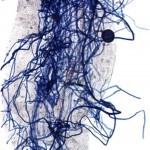The root of the problem
When it comes to knowing what plants do underground, we are literally in the dark. It’s so much easier to work on the aboveground parts of plants that we often ignore what’s going on belowground. But, as the roots supply the plant with essential inorganic nutrients, no picture of plant ecology is complete without them.
Friends and enemies

This root hair (pale grey) is heavily infected with beneficial mycorrhizal fungi (blue) which provide phosphate to the plant in return for carbon compounds. Photo courtesy of Alicia Arguello.
The roots of a plant are certainly not alone. Roots make contact with, and are influenced by, many other organisms. Some of these are highly beneficial, in particular there is a group of fungi called mycorrhizas that form symbiotic relationships with plants. With their extensive network of fungal hyphae, mycorrhizas explore the soil and are particularly good at picking up inorganic phosphate, which is supplied to the plant in return for carbon compounds. Unfortunately, the soil is also full of enemies: root-feeding nematodes as well as pathogenic fungi and bacteria are all too keen to make a living on the nutritious root tissues. Some of these pathogens are highly damaging and can severely reduce crop yields if they are not properly managed.
Rotation
An agricultural revolution in Europe occurred when farmers realised that they should rotate their crops in order to prevent what was known at the time as ‘soil sickness’. Today we recognise that soil sickness is caused by the build up of soil pathogens, and crop rotations remain one of the best tools to keep them at bay. These pathogens normally attack a limited number of species, so changing the crop helps to keep them under control. Much more recently, ecologists also realised that the same mechanism could operate in natural communities of wild plants. In this case, plants in a diverse community are less likely to reoccupy the same site year after year because of pathogen build-up. This promotes diversity because each species starts to suffer a disadvantage on its ‘home’ soil, which leads to a different species taking its place.
Experimental test
Jana Petermann and Alex Ferguson tested this idea as part of their PhD work. They removed soil from monoculture plots which were part of an experiment investigating the effect of species diversity on productivity. They then re-grew each species alone and in competition on different soils, and crucially they included several soil treatments – including sterilisation – which kills all soil organisms. They found that each species when in competition performed badly when trying to regrow on ‘home’ soil – that is, soil that the species had previously occupied. Only one treatment could remove this effect, and that was sterilisation, thus demonstrating that it was the living component of the soil that drove the effect.
Links
Petermann J, A Fergus, LA Turnbull, and Schmid B. (2008) Janzen-Connell effects are widespread and strong enough to maintain diversity in grasslands. Ecology, 89, 2399-2406. (Faculty of 1000 must-read)
